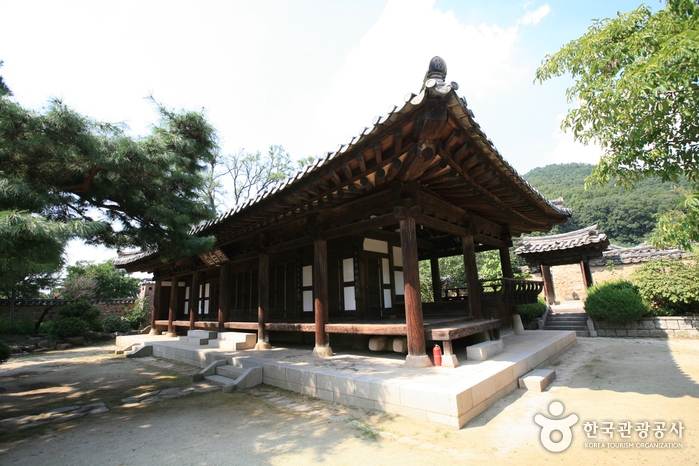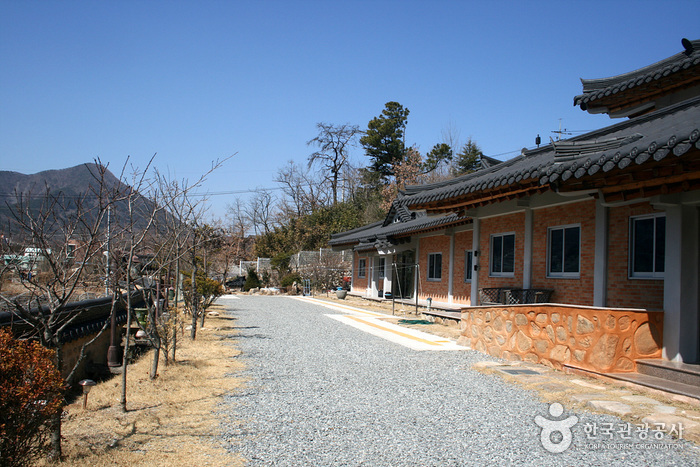Geumgang Station Rail Café (Banyawol Lotus Village Cooperative) (금강역 레일 카페(반야월 연꽃마을 협동조합))
11.4Km 2024-02-15
153 Geumgang-ro, Dong-gu, Daegu
Geumgang Station Rail Café, located right next to Geumgang Station on the Daegu Line, is a unique café housed in two Saemaeul-ho train cars. It offers affordable coffee and beverages, along with muffins and cookies made from lotus roots. Adjacent to the café is a lotus field, and during the summer, the beauty of blooming lotus reaches its peak.
Village of the Nampyeong Mun Clan in Bon-ri (남평문씨본리세거지)
11.4Km 2021-03-16
16, Inheung 3-gil, Dalseong-gun, Daegu
+82-53-668-3162
The Village of the Nampyeong Mun Clan in Bon-ri was built on what used to be part of a temple, but was organized following a well-field system to make the area a residence for many generations. As of now, nine houses and two pavilions remain, as well as a low wall along the road.
The main building of the village is Subongjeongsa, located in the center of the area. It was used for meeting guests, as well as a gathering place for the family, and features beautiful gardens. Gwanggeodang Hall was an educational place for studies and refinement. Insumungo Storage Building preserves about 10,000 books and clan treasures. It started out as a small building but later was expanded, including an additional building constructed just to read books.
Keimyung University Dongsan Hospital (계명대학교 동산병원)
11.5Km 2025-07-07
1035 Dalgubeol-daero, Dalseo-gu, Daegu
Established in 1899 as Daegu's first Western medical institution, Keimyung University Dongsan Hospital is a cutting-edge, eco-friendly facility offering 37 specialties. It features top centers for cancer, robotic surgery, cardiocerebrovascular diseases, and organ transplants. In 2023, it won the Medical Korea Award for cancer care. The International Healthcare Center has been providing personalized services to international patients since 1967.
Daemyeong Reservoir (대명유수지)
11.5Km 2024-02-15
816 Daecheon-dong, Dalseo-gu, Daegu
Daemyeong Reservoir, located adjacent to Dalseong Marsh, is at the convergence point of the Nakdonggang River, Geumhogang River, Daemyeongcheon Stream, and Jincheon Stream. This area is a rich ecological reserve, home to a diverse range of wildlife including the narrow-mouthed toad, leopard cat, weasel, common kestrel, and water deer, along with various wild plants. Visitors to the area can explore narrow-mouthed toad habitats, observation decks, ecological exploration trails, and photo zones. There's also a narrow-mouthed toad ecological learning center for educational experiences. The surrounding landscape, with its stretches of silver grass and reeds along the walking decks, offers a picturesque setting, particularly attractive for autumn photography.
Gooam Farmstay Village (구암팜스테이마을)
11.6Km 2024-03-15
8-1 Guam-gil, Dong-gu, Daegu
+82-53-984-5273
Known as "Gooam" due to its rock formations resembling turtle's shell, Gooam Farmstay Village offers various activities such as harvesting agricultural produce, traditional food making, traditional games, and craft experiences. Depending on the season, there are experiences like picking strawberries, digging potatoes, picking cherry tomatoes, gathering chestnuts, and harvesting persimmons. Visitors can also participate in making bean curd, rice cakes, kimchi, catching loaches, making kite, and experiencing hanji crafts.
ER NC Department Store - Kyungsan Branch [Tax Refund Shop] (ER NC백화점 경산)
12.0Km 2024-04-18
39, Jungang-ro, Gyeongsan-si, Gyeongsangbuk-do
-
Dalseong Marsh (대구 달성습지)
12.1Km 2025-06-10
88 Gura 1-gil, Hwawon-eup, Dalseong-gun, Daegu
Dalseong Marsh is located in the meeting point of Nakdonggang River, Geumghogang River, Jincheoncheon Stream, and Daemyeongcheon Stream. Spanning an area of 2 ㎢, the marsh comprises wetlands and freshwater lake where various seasonal aquatic plants are grown. It is also home to several different species of migratory birds.
Olive Young - Gyeongsan Market Branch [Tax Refund Shop] (올리브영 경산시장점)
12.2Km 2024-06-27
78, Jungang-ro, Gyeongsan-si, Gyeongsangbuk-do
-
Hwawon Park (화원동산)
12.7Km 2024-04-08
40-14 , Samunjin-ro 1-gil, Dalseong-gun, Daegu
+82-53-659-4465
Hwawon Park, a vast park beside the Nakdonggang River, is steeped in history. The river, once bustling with Samunjin Quay, where ships laden with goods frequented, now features Samunjin Ferries. Visitors can access Dalseong Marsh Ecological Park via a floating walkway across the river. In the vicinity, the Samunjin Jumakchon Village offers traditional beverages and delicacies, including makgeolli (unrefined rice wine) and pajeon (green onion pancake). With well-maintained walking trails, cafés, and picnic spots, the park serves as an ideal destination for family outings.
Museum of Natural Dye Arts (자연염색박물관)
12.8Km 2021-03-19
17, Pagye-ro 112-gil, Dong-gu, Daegu
+82-53-981-4330
The Museum of Natural Dye Arts was formed to collect and preserve the traditional way of dyeing, as well as inform the high quality of Korean natural dye to the world. The museum has various art products from around the world. Divided into two floors, Ahwon Gallery on the first floor showcases replicas of ancient dyeing tools and provides information on the natural dyeing process. The Relic Hall on the second floor displays pieces of ancient artwork including fabric, clothes, pillows, blankets and accessories, all made using different methods such as dyeing, embroidery, quilting, knotting and sewing.


![ER NC Department Store - Kyungsan Branch [Tax Refund Shop] (ER NC백화점 경산)](http://tong.visitkorea.or.kr/cms/resource/57/2883757_image2_1.jpg)

 English
English
 한국어
한국어 日本語
日本語 中文(简体)
中文(简体) Deutsch
Deutsch Français
Français Español
Español Русский
Русский